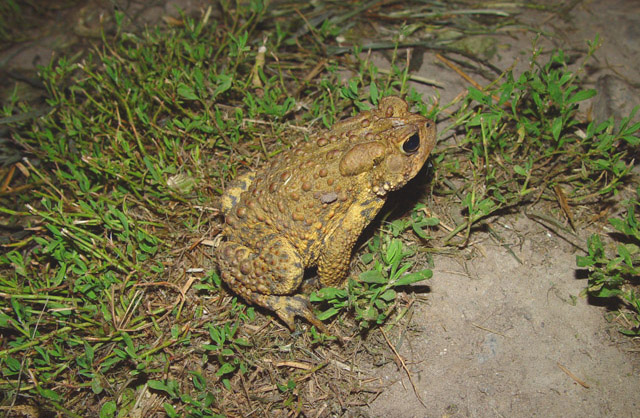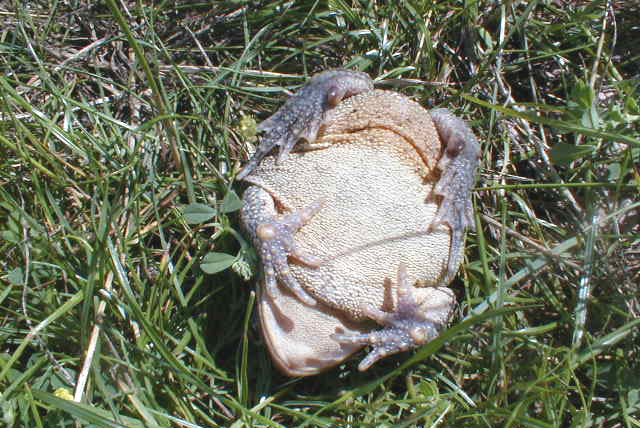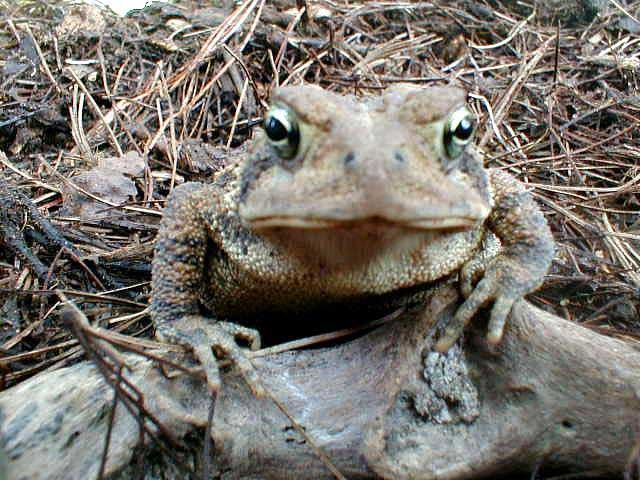The American Toad
Bufo americanus
Bufo americanus, Peterborough, Ontario, courtesy of Tim Dyson copyright

Bufo americanus, Peterborough, Ontario, courtesy of Tim Dyson copyright
This amphibian doesn't need much water for breeding, but it does need some. Springtime pools, puddles in roadside ditches, natural and artificial ponds, and streams provide the necessary habitat for breeding and egg laying from March to early June.
Small eggs (black on top, white on the bottom), in jelly-like strands, hatch into tiny black tadpoles. The tadpoles develop rapidly in fresh water and metamorphose into half inch long toadlets.
I spent my teen years in Pottersville, New Jersey. Our land's lower boundary bordered the Black River, and shortly after my father purchased the property, he had a front end loader come in and excavate a pond, fed by the river.
The pond provided us with some fine swimming and fishing and probably also served as a breeding ground for many frogs, toads and turtles.
Frequently the toads would come near the house, and they would congregate under lights left on to attract night-flying Saturniidae and Sphingidae and Catocala (large and attractive moths).
The toads, some small (about one inch long) and some big (about three inches long), would hop about our patio, gobbling up beetles and katydids and other insects that hit the ground.
It wasn't hard to catch and examine these warty creatures and it was fun to turn them on their backs and tickle their bellies with a gentle finger stroke.

Bufo americanus, with permission from www.turtletails.com
We soon grew accustomed to the toads and they did not seem fearful of us. They would even come and accept beetles from our fingers.
I was amazed that our three Labrador retrievers would also leave the hoppers alone. Occasionally one of the dogs was enticed to inspect a toad in hot pursuit of a low flying moth, but there was never any mouthing or biting, usually nothing more than a good sniff.
One summer we had a coop full of chickens, and the chickens attracted some weasels, and that spurred my father to action!
We learned an interesting fact about these toads from that encounter.
My father noticed the mother weasel (Mustela frenata) and two smaller offspring crossing the field and heading for the chicken coop. He knew how quick and deadly these predators could be and grabbed the closest deterrent he could find, a trout fishing landing-net.
At the edge of the coop he managed to capture one of the young ones and dropped it into a screen cage for observation.
Another young one was soon captured and caged, and the mother turned her attention from the chickens and escaping to her babies.
She too was soon captured, unharmed, and dropped into the cage.
My father explained that even though these carnivores were coming to kill and eat the chickens, the weasels weren't bad. They were just doing what nature intended. He had no desire to kill the invaders; he only wanted to protect the chickens.
My father disinfected and dressed the single wound he had received in the chase. One of the weasels had managed a nasty bite into one of his fingers, and the blood was flowing freely.
And so the family got to observe the caged weasels. We learned that weasels are carnivores that kill and eat fish, birds, amphibians and small mammals. They will even move into a rabbit's den after killing and eating the orignal inhabitants.
These captives had to eat too. Our closest food supply was a nearby, abandoned ice pond with an abundance of frogs.
I was amazed at the speed and ferocity of the weasels when live food was dropped into their cage. Fortunately the frog did not suffer greatly as the furry mamamals attacked with lightning speed. Death was very quick. I felt bad for the amphibian, but realized if the weasels weren't in the cage eating the frog, they would be elsewhere killing and eating rabbits, mice, frogs or CHICKENS.
I can't remember how long we had the weasels (probably just a couple of days), but I enjoyed watching them when they were not killing and eating. They had sleek coats and their movements were deft and sure with nervous and muscular systems working in beautiful harmony.
Their eyes, however, were haunting, as they seemed to have none of the warmth associated with other more familiar mammals. I do not think they could ever be domesticated.
One day our family was in a bit of a rush to embark on an outing. The weasels needed to be fed, and there was a toad which seemed to have presented itself as a convenient offering in broad daylight on our patio.
Rather than make the time consuming trek to the ice pond to capture a frog, the toad was gathered up and offered to the weasels.
As soon as the toad was dropped into the cage, the weasels attacked visciously. Immediately, however, one after the other, they quickly released their bite holds and began pawing frantically at their own mouths.
The attackers wanted nothing more to do with the toad which at least had been mercifully killed with the first bite to the back of its neck.
The pawing continued for some time until the weasels seemed to grow tired and began to rest. The next day the killers were dead!
We were disappointed with their demise as we had intended to contact the New Jersey Department of Fish and Wildlife to have them taken away and released far from our home or anyone's chickens. Of even greater concern, though, was the bite my father had incurred during their capture. His immediate thought was rabies.
The dead weasels were put into plastic bags and put into the freezer until someone from Fish and Wildlife could come to pick them up for examination to determine cause of death.
The subsequent report indicated rabies was not the problem. We learned that toads have poison glands on their backs. We never should have offered a toad to the weasels.
As far as I know, there is no potential risk to humans from the casual handling of Bufo americanus. They are interesting creatures. As adults they may not have any natural enemies.
The first time you capture and hold one, however, the nervous toad may expel some liquid onto your hands -- not poison, just urine.
You decide!
Be nice, however, or you will have some angry toads "in your face"!

Bufo americanus, with permission from www.turtletails.com